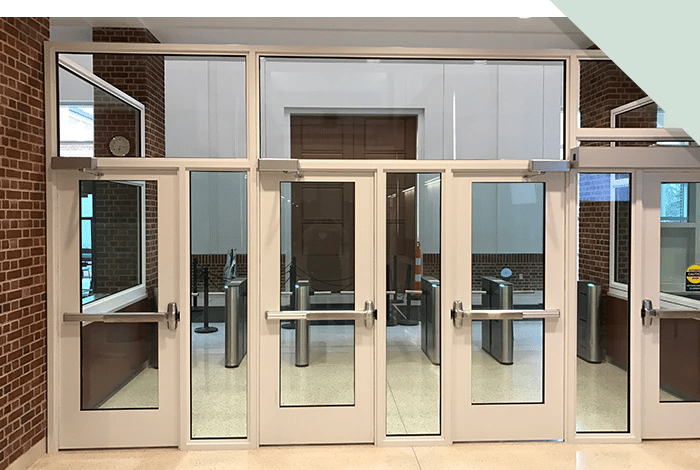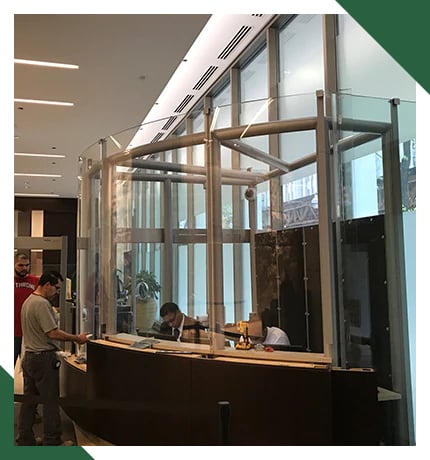Secure Entryways and Vestibules
Controlling the flow of people entering your building is paramount to any safety plan. We’re here to help you create a custom system that makes access control easy. Security-savvy business owners know that this often requires more than just a single lockable door. By taking steps to enhance the safety of your entryways, you help ensure that every person who steps inside your doors is meant to be there.


First Line of Defense: Access Control for Any Facility
While the finished product of any custom system from TSS will depend on your unique building features, universal benefits of our bullet-resistant barriers include:
- Prevent unwanted outside access to your building while still welcoming staff and guests into your space.
- Create a checkpoint where personnel and visitors can gain entry through additional security measures such as automatic card readers or a receptionist.
- Provide a temporary waiting area indoors where a limited number of visitors can safely request access to your building.
These custom solutions are best suited for facilities with a low to moderate flow of public traffic and that may admit employees or visitors on an individual basis. If your operations rely on an open reception area or lobby to accommodate high traffic flow from outside visitors - such as a multi-tenant office building, medical facility, or municipal building - you may prefer to explore the possibilities of a secure reception area.
What Does a Secure Entryway Look Like?
For many clients, we recommend multiple sets of bullet-resistant doors that form a secure vestibule design. Employees and visitors will enter an initial set of exterior-facing doors, then need to complete a secondary action to pass through a set of secure interior doors (like using an electronic card reader). Every ballistic door system is customizable, and we’ll work with you to find solutions that preserve your building aesthetics while providing safety for your team.
Taking a Systems Approach to Securing Your Building
No single bulletproof item provides adequate protection on its own. A systems approach is the best way to protect your people and property. Starting with your building’s exterior and entryway, we take a look at common areas in any facility where bullet-resistant systems should be installed to create a cohesive ballistic security system.
Frequently Asked Questions
Can I convert my existing security vestibule entry into a ballistic entryway?
Yes. Most buildings already have a vestibule-style entrance that can be secured with a few smart upgrades. A typical renovation includes replacing interior doors with heavier or bullet-resistant models, adding access control, and integrating a communication system or transaction window. This allows reception staff to safely screen visitors before granting entry, without disrupting your building’s flow or aesthetics.
Do I need to replace my building’s exterior doors to install a secure access control vestibule?
Not usually. In most access control vestibule renovations, your existing outer doors can remain in place. The focus is on upgrading the interior entry point to control access and improve safety without requiring a full rebuild of your entrance.
Does a ballistic secure vestibule also provide forced-entry resistance?
When designed correctly, a secure vestibule can help resist forced entry as well as gunfire. It requires the use of materials and components that are tested for both ballistic and physical attack scenarios. At TSS, we tailor each vestibule to meet your security goals, including enhanced protection against forced entry where needed.
What makes a secure vestibule from TSS different from off-the-shelf solutions?
The true value of a TSS secure vestibule is customization. We design each system to integrate seamlessly with your existing architecture, operations, and security technology.
Does TSS offer other custom security solutions beyond vestibules?
While secure vestibules are a common starting point, TSS designs and installs a wide range of custom ballistic solutions to meet your facility’s specific needs. This includes safe rooms, secure transaction counters, reinforced exit corridors, and ballistic protection for executive floors and offices.